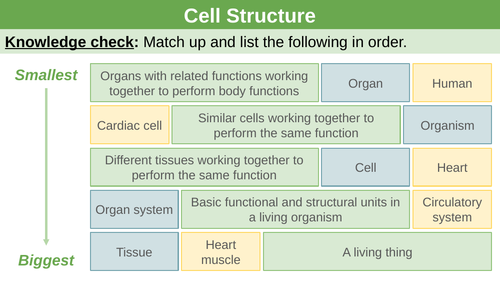






✓ Engaging presentation
✓ Includes lots of examples and definitions
✓ Lots of short AFL tasks
✓ Exam question examples
This lesson on Cell Structure is designed for KS4 Science students enrolled in the CIE Cambridge IGCSE Biology 0610 (2026-28) course. This is the first lesson in the topic 1 Organisation of the Organism.
The lesson recaps previous learning from other linked topics to ensure students have a strong foundation before diving into the material. It also includes concise and easy-to-understand information and a variety of quick assessment for learning tasks to help students solidify their understanding of the topic. There is a strong emphasis on answering exam questions, with examples and the mark scheme included in the presentation.
Objectives:
- Describe and compare the structure of a plant cell with an animal cell, limited to: cell wall, cell membrane, nucleus, cytoplasm, chloroplasts,
ribosomes, mitochondria, vacuoles - Describe the structure of a bacterial cell, limited to: cell wall, cell membrane, cytoplasm, ribosomes, circular DNA, plasmids
- Identify the cell structures listed in 2.1.1 and 2.1.2 in diagrams and images of plant, animal and bacterial cells
- Describe the functions of the structures listed in 2.1.1 and 2.1.2 in plant, animal and bacterial cells
- State that new cells are produced by division of existing cells
- State that specialised cells have specific functions, limited to: (a) ciliated cells – movement of mucus in the trachea and bronchi (b) root hair cells – absorption © palisade mesophyll cells – photosynthesis (d) neurones – conduction of electrical impulses (e) red blood cells – transport of oxygen (f) sperm and egg cells (gametes) – reproduction
- Describe the meaning of the terms: cell, tissue, organ, organ system and organism as illustrated by examples given in the syllabus
This lesson would also be adaptable for all GCSE students (whether AQA, Edexcel, OCR) and great for KS3 Science or as a GCSE revision resource.
Something went wrong, please try again later.
This resource hasn't been reviewed yet
To ensure quality for our reviews, only customers who have purchased this resource can review it
Report this resourceto let us know if it violates our terms and conditions.
Our customer service team will review your report and will be in touch.